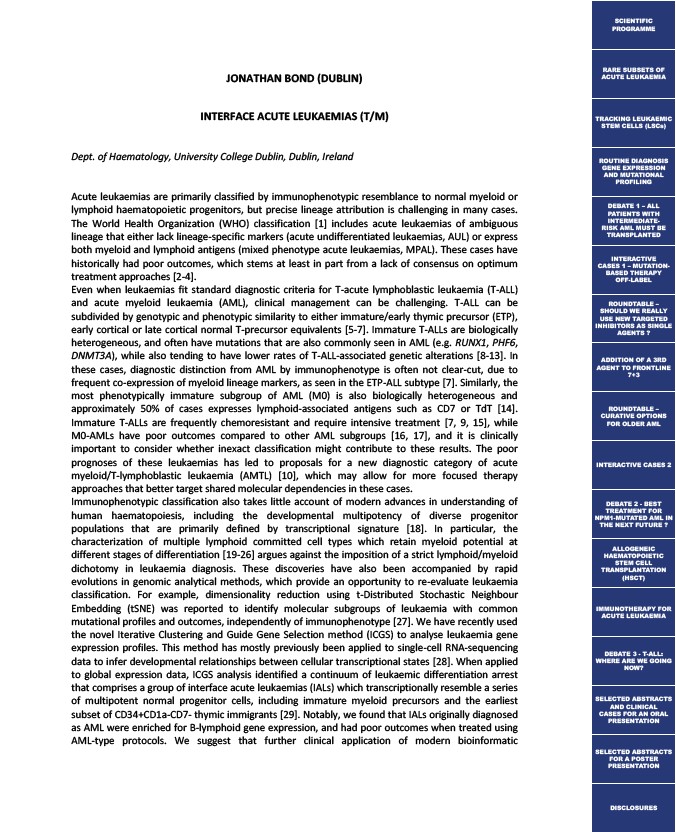
JONATHAN BOND (DUBLIN)
INTERFACE ACUTE LEUKAEMIAS (T/M)
Dept. of Haematology, University College Dublin, Dublin, Ireland
Acute leukaemias are primarily classified by immunophenotypic resemblance to normal myeloid or
lymphoid haematopoietic progenitors, but precise lineage attribution is challenging in many cases.
The World Health Organization (WHO) classification 1 includes acute leukaemias of ambiguous
lineage that either lack lineage-specific markers (acute undifferentiated leukaemias, AUL) or express
both myeloid and lymphoid antigens (mixed phenotype acute leukaemias, MPAL). These cases have
historically had poor outcomes, which stems at least in part from a lack of consensus on optimum
treatment approaches 2-4.
Even when leukaemias fit standard diagnostic criteria for T-acute lymphoblastic leukaemia (T-ALL)
and acute myeloid leukaemia (AML), clinical management can be challenging. T-ALL can be
subdivided by genotypic and phenotypic similarity to either immature/early thymic precursor (ETP),
early cortical or late cortical normal T-precursor equivalents 5-7. Immature T-ALLs are biologically
heterogeneous, and often have mutations that are also commonly seen in AML (e.g. RUNX1, PHF6,
DNMT3A), while also tending to have lower rates of T-ALL-associated genetic alterations 8-13. In
these cases, diagnostic distinction from AML by immunophenotype is often not clear-cut, due to
frequent co-expression of myeloid lineage markers, as seen in the ETP-ALL subtype 7. Similarly, the
most phenotypically immature subgroup of AML (M0) is also biologically heterogeneous and
approximately 50% of cases expresses lymphoid-associated antigens such as CD7 or TdT 14.
Immature T-ALLs are frequently chemoresistant and require intensive treatment 7, 9, 15, while
M0-AMLs have poor outcomes compared to other AML subgroups 16, 17, and it is clinically
important to consider whether inexact classification might contribute to these results. The poor
prognoses of these leukaemias has led to proposals for a new diagnostic category of acute
myeloid/T-lymphoblastic leukaemia (AMTL) 10, which may allow for more focused therapy
approaches that better target shared molecular dependencies in these cases.
Immunophenotypic classification also takes little account of modern advances in understanding of
human haematopoiesis, including the developmental multipotency of diverse progenitor
populations that are primarily defined by transcriptional signature 18. In particular, the
characterization of multiple lymphoid committed cell types which retain myeloid potential at
different stages of differentiation 19-26 argues against the imposition of a strict lymphoid/myeloid
dichotomy in leukaemia diagnosis. These discoveries have also been accompanied by rapid
evolutions in genomic analytical methods, which provide an opportunity to re-evaluate leukaemia
classification. For example, dimensionality reduction using t-Distributed Stochastic Neighbour
Embedding (tSNE) was reported to identify molecular subgroups of leukaemia with common
mutational profiles and outcomes, independently of immunophenotype 27. We have recently used
the novel Iterative Clustering and Guide Gene Selection method (ICGS) to analyse leukaemia gene
expression profiles. This method has mostly previously been applied to single-cell RNA-sequencing
data to infer developmental relationships between cellular transcriptional states 28. When applied
to global expression data, ICGS analysis identified a continuum of leukaemic differentiation arrest
that comprises a group of interface acute leukaemias (IALs) which transcriptionally resemble a series
of multipotent normal progenitor cells, including immature myeloid precursors and the earliest
subset of CD34+CD1a-CD7- thymic immigrants 29. Notably, we found that IALs originally diagnosed
as AML were enriched for B-lymphoid gene expression, and had poor outcomes when treated using
AML-type protocols. We suggest that further clinical application of modern bioinformatic
SCIENTIFIC
PROGRAMME
RARE SUBSETS OF
ACUTE LEUKAEMIA
TRACKING LEUKAEMIC
STEM CELLS (LSCs)
ROUTINE DIAGNOSIS
GENE EXPRESSION
AND MUTATIONAL
PROFILING
DEBATE 1 – ALL
PATIENTS WITH
INTERMEDIATE-RISK
AML MUST BE
TRANSPLANTED
INTERACTIVE
CASES 1 – MUTATION-BASED
THERAPY
OFF-LABEL
ROUNDTABLE –
SHOULD WE REALLY
USE NEW TARGETED
INHIBITORS AS SINGLE
AGENTS ?
ADDITION OF A 3RD
AGENT TO FRONTLINE
7+3
ROUNDTABLE –
CURATIVE OPTIONS
FOR OLDER AML
INTERACTIVE CASES 2
DEBATE 2 - BEST
TREATMENT FOR
NPM1-MUTATED AML IN
THE NEXT FUTURE ?
ALLOGENEIC
HAEMATOPOIETIC
STEM CELL
TRANSPLANTATION
(HSCT)
IMMUNOTHERAPY FOR
ACUTE LEUKAEMIA
DEBATE 3 - T-ALL:
WHERE ARE WE GOING
NOW?
SELECTED ABSTRACTS
AND CLINICAL
CASES FOR AN ORAL
PRESENTATION
SELECTED ABSTRACTS
FOR A POSTER
PRESENTATION
DISCLOSURES